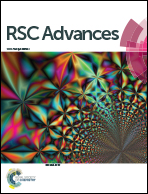The partially controllable growth trend of carbon nanoparticles in solid-state pyrolysis of organometallic precursor by introducing POSS units, and their magnetic properties†
Abstract
On the basis of organometallic compound T (without POSS unit), compound PT containing three POSS units was synthesized for solid-state pyrolysis. It was found that the introduction of POSS units could prevent metal nanoparticles from sintering into larger particles effectively, and change the growth trend of carbon nanoparticles. When the pyrolysis temperature was increased from 700 to 850 °C, as for compound T, the metal particles sintered considerably, and the morphology of the obtained materials were gradually transformed from carbon nanotubes to hollow carbon nanospheres. However, compound PT exhibited good sinter-resistant performance: the size of the metal particles did not obviously increase with the raised temperature. In comparison with T, the growth trend of carbon nanoparticles in solid-state pyrolysis of PT was exactly opposite, showing a trend of producing carbon nanotubes upon the increased pyrolysis temperature. Meanwhile, the obtained nanomaterials all demonstrated good magnetic properties, with the highest saturation magnetization (Ms) as 64.9 emu g−1, and the magnetic properties exhibited a good accordance with their structure.


 Please wait while we load your content...
Please wait while we load your content...